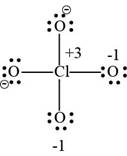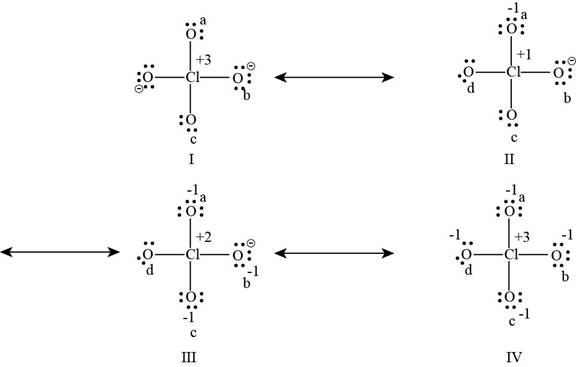
Concept explainers
Interpretation: The Lewis structure and shape of the given compound, the hybridization of the central atom and the resonating structure that has formal charge close to zero is to be identified.
Concept introduction: The Lewis structure represents all bonding and non-bonding electrons surrounding the atoms involved in a molecule. A molecule exhibits a particular geometry in space considering the steric hindrances of the bond pairs and the lone pairs of electron.
Resonance structures are different forms of a molecule in which the chemical connectivity of the atoms in a molecule is same but there distribution of electrons is different.
The formal charge is calculated by the formula,
To determine: The Lewis structure and shape of the given compound, the hybridization of the central atom and the resonating structure that has formal charge close to zero.
Answer to Problem 9.65QP
Solution
The Lewis structure of
The resonating structure I has formal charge close to zero.
The shape of the molecule is tetrahedral and the hybridization of the chlorine is
Explanation of Solution
Explanation
The
The electronic configuration of
The number of valence electrons of
The atomic number of
The electronic configuration of
The number of valence electrons of
The total number of valence electrons of
The Lewis structure of

Figure 1
Resonance structures are different forms of a molecule in which the chemical connectivity of the atoms in a molecule is same but there distribution of electrons is different.
The resonance structure of

Figure 2
The formal charge is calculated by the formula,
According to the I resonating structure of the given compound from figure 2,
- Chlorine has fourteen bonding and zero nonbonding electrons.
- Oxygen (a) has four bonding electrons and four nonbonding electrons.
- Oxygen (b) has two bonding and six nonbonding electrons.
- Oxygen (c) has four bonding electrons and four nonbonding electrons.
- Oxygen (d) has four bonding and four nonbonding electrons.
The formal charge of chlorine in resonating structure 1 is calculated as,
The formal charge of oxygen (a) in resonating structure 1 is calculated as,
The formal charge of oxygen (b) in resonating structure 1 is calculated as,
The formal charge of oxygen (c) in resonating structure 1 is calculated as,
The formal charge of oxygen (d) in resonating structure 1 is calculated as,
According to the II resonating structure of the given compound from figure 2,
- Chlorine has twelve bonding and zero nonbonding electrons.
- Oxygen (a) has two bonding electrons and six nonbonding electrons.
- Oxygen (b) has two bonding and six nonbonding electrons.
- Oxygen (c) has four bonding electrons and four nonbonding electrons.
- Oxygen (d) has four bonding and four nonbonding electrons.
The formal charge of chlorine in resonating structure 1 is calculated as,
The formal charge of oxygen (a) in resonating structure 1 is calculated as,
The formal charge of oxygen (b) in resonating structure 1 is calculated as,
The formal charge of oxygen (c) in resonating structure 1 is calculated as,
The formal charge of oxygen (d) in resonating structure 1 is calculated as,
According to the II resonating structure of the given compound from figure 2,
- Chlorine has fourteen bonding and zero nonbonding electrons.
- Oxygen (a) has four bonding electrons and six nonbonding electrons.
- Oxygen (b) has two bonding and six nonbonding electrons.
- Oxygen (c) has four bonding electrons and six nonbonding electrons.
- Oxygen (d) has four bonding and four nonbonding electrons.
The formal charge of chlorine in resonating structure 1 is calculated as,
The formal charge of oxygen (a) in resonating structure 1 is calculated as,
The formal charge of oxygen (b) in resonating structure 1 is calculated as,
The formal charge of oxygen (c) in resonating structure 1 is calculated as,
The formal charge of oxygen (d) in resonating structure 1 is calculated as,
According to the IV resonating structure of the given compound from figure 2,
- Chlorine has ten bonding and zero nonbonding electrons.
- Oxygen (a) has two bonding electrons and six nonbonding electrons.
- Oxygen (b) has two bonding and six nonbonding electrons.
- Oxygen (c) has two bonding electrons and six nonbonding electrons.
- Oxygen (d) has four bonding and four nonbonding electrons.
The formal charge of chlorine in resonating structure 1 is calculated as,
The formal charge of oxygen (a) in resonating structure 1 is calculated as,
The formal charge of oxygen (b) in resonating structure 1 is calculated as,
The formal charge of oxygen (c) in resonating structure 1 is calculated as,
The formal charge of oxygen (d) in resonating structure 1 is calculated as,
Resonating structure 1 has formal charge close to zero
The molecular shape of
From the resonating structure I it is concluded that the chlorine atom forms three pi bonds this means it uses three
Conclusion
The Lewis structure of
The resonating structure I has formal charge close to zero.
The shape of the molecule is tetrahedral and the hybridization of the chlorine is
Want to see more full solutions like this?
Chapter 9 Solutions
EBK CHEMISTRY: THE SCIENCE IN CONTEXT,
- Stuc X ctclix ALE X A ALE אן A ALEX Lab (195 X Nut x M Inb x NU X NUT X Unt x + → C www-awu.aleks.com/alekscgi/x/Isl.exe/10_u-lgNslkr7j8P3jH-IQ1g8NUi-mObKa_ZLx2twjEhK7mVG6PulJI006NcKTV37JxMpZuyrVCdQolLAKqp_7U3r1GUD3... New Chrome available: Naomi Question 26 of 39 (4 points) | Question Attempt: 1 of Unlimited Give the IUPAC name. 2,3-dimethylhexane Part: 1/2 Part 2 of 2 Draw the skeletal structure of a constitutional isomer of the alkane above that contains a different number of carbons in its longest chain. Skip Part Check Click and drag to start drawing a structure. 3 Finance headline Q Search mwa Harvard Intensifi... X Save For Later 00 dlo HB Submit Assignment 2025 McGraw Hill LLC. All Rights Reserved. Terms of Use | Privacy Center | Accessibility a 9:11 PM 4/22/2025arrow_forwardPredict the product of this organic reaction: + NH2 HO A P+ H2O Specifically, in the drawing area below draw the skeletal ("line") structure of P. If there is no reasonable possibility for P, check the No answer box under the drawing area. Click and drag to start drawing a structure. ✓arrow_forward个 Stuc X ctclix ALE X A ALE × A ALE X Lab x (195 × Nut x M Inbx EF 目 → C www-awu.aleks.com/alekscgi/x/Isl.exe/10_u-IgNslkr7j8P3jH-IQ1g8NUi-mObKa_ZLx2twjEhK7mVG6PulJI006NcKTV37JxMpz Chapter 12 HW = Question 27 of 39 (5 points) | Question Attempt: 1 of Unlimited Part: 1/2 Part 2 of 2 Give the IUPAC name. Check 3 50°F Clear ©2025 McGraw Hill L Q Search webp a عالياكarrow_forward
- 个 Stuck x ctc xALE X A ALE × A ALE X Lab x (19: x - G www-awu.aleks.com/alekscgi/x/Isl.exe/10_u-lgNslkr7j8P3jH-1Q1g8NUi-mObka ZLx2twjEhK7mVG6PUUIO06 Chapter 12 HW 三 Question 26 of 39 (4 points) 1 Question Attempt: 1 of Unlimited Answer the following questions about the given alkane. Part: 0 / 2 Part 1 of 2 Give the IUPAC name. Skip Part 2 53°F Clear Check × Q Search hp hp 02arrow_forwardCalculate the equilibrium constant at 25.0 oC for the following equation. Cd(s) + Sn+2(aq) ↔Cd+2(aq) + Sn(s) Group of answer choices 3.11x104 1.95x1018 9.66x108 1.40x109arrow_forwardWhat is the pH at the cathode for the following cell written in line notation at 25.0 oC with a Ecell = -0.2749 V? Ni(s)|Ni+2(aq, 1.00 M)||H+1(aq, ?M)|H2(g, 1.00 atm)|Pt(s)arrow_forward
- Calculate Ecell for a hydrogen fuel cell at 95.0 oC using the following half-reactions with PH2 = 25.0 atm and PO2 = 25.0 atm. O2(g) + 4H+1(aq) + 4e-1 → 2H2O(l) Eo = 1.229 V 2H2(g) → 4H+1(aq) + 4e-1 Eo = 0.00 Varrow_forwardCalculate Ecell at 25.0 oC using the following half-reactions with [Ag+1] = 0.0100 M and [Sn+2] = 0.0200 M. Ag+1(aq) + 1e-1 Ag(s) Sn+2(aq) + 2e-1 Sn(s)arrow_forwardDone 18:19 www-awu.aleks.com Chapter 12 HW Question 27 of 39 (5 points) | Question Attempt: 1 of Unlimited .. LTE סוי 9 ✓ 20 ✓ 21 × 22 23 24 25 26 27 28 29 30 Answer the following questions about the given alkane. Part: 0 / 2 Part 1 of 2 Classify each carbon atom as a 1º, 2º, 3º, or 4°. Highlight in red any 1° carbons, highlight in blue any 2° carbons. highlight in green any 3° carbons, and leave any 4° carbons unhighlighted. Skip Part Check Save For Later © 2025 McGraw Hill LLC. All Rights Reserved. Terms of Use Privacy Center | Accessibility ☑ คarrow_forward
- < Done 19:22 www-awu.aleks.com Chapter 12 HW Question 4 of 39 (2 points) | Question Attempt: 5 of Unlimited : .. LTE סוי 1 ✓ 2 ✓ 3 = 4 ✓ 5 ✓ 6 ✓ 7 ✓ 8 ✓ 9 = 10 11 ✓ 12 Consider the molecule (CH3)2CHCH2CHCн for the following questions. Part 1 of 2 Which of the following molecules is/are constitutional isomer(s) to (CH3)2CHCH2CH2CH3? Check all that apply. Part 2 of 2 (CH3),C(CH2)2CH3 CH3 H,C-CH-CH-CH, CH 3 None of the above. ☑ Which of the following molecules is/are identical molecules to (CH3)2CHCH2CH2CH₁₂? Check all that apply. CH3 H,C-CH-CH₂-CH2-CH, CH3(CH2)2CH(CH3)2 CH2-CH2-CH3 HỌC-CH=CH, 乂 ☑ а None of the above Check Save For Later Submit Assignment © 2025 McGraw Hill LLC. All Rights Reserved. Terms of Use | Privacy Center Accessibilityarrow_forward18:11 LTE ا... US$50 off hotels is waiting for you Book now, hotels in Nashville are going fast QUTSLIVII 25 61 69 points) | QuestIVIT ALLēm... now Give the IUPAC name for each compound. Part 1 of 3 Part 2 of 3 X ☑ Х Check Save For Later Submit © 2025 McGraw Hill LLC. All Rights Reserved. TOMS CT US ...vacy Center | Accessibilityarrow_forwardDone 19:17 www-awu.aleks.com Chapter 12 HW Question 29 of 39 (6 points) | Question Attempt: 1 of Unlimited .III LTE סוי 27 28 = 29 30 31 32 = 33 34 35 Consider this structure. CH3CH2CH2 Part 1 of 3 3 CH2 CH2CH3 - C-CH2CH 3 H CH₂ Give the IUPAC name of this structure. 3-ethyl-3,4-dimethylheptane Part: 1/3 Part 2 of 3 Draw the skeletal structure. Skip Part < Check Click and drag to start drawing a structure. Save For Later Submit © 2025 McGraw Hill LLC. All Rights Reserved. Terms of Use | Privacy Center | Accessibility Хarrow_forward
 ChemistryChemistryISBN:9781305957404Author:Steven S. Zumdahl, Susan A. Zumdahl, Donald J. DeCostePublisher:Cengage Learning
ChemistryChemistryISBN:9781305957404Author:Steven S. Zumdahl, Susan A. Zumdahl, Donald J. DeCostePublisher:Cengage Learning ChemistryChemistryISBN:9781259911156Author:Raymond Chang Dr., Jason Overby ProfessorPublisher:McGraw-Hill Education
ChemistryChemistryISBN:9781259911156Author:Raymond Chang Dr., Jason Overby ProfessorPublisher:McGraw-Hill Education Principles of Instrumental AnalysisChemistryISBN:9781305577213Author:Douglas A. Skoog, F. James Holler, Stanley R. CrouchPublisher:Cengage Learning
Principles of Instrumental AnalysisChemistryISBN:9781305577213Author:Douglas A. Skoog, F. James Holler, Stanley R. CrouchPublisher:Cengage Learning Organic ChemistryChemistryISBN:9780078021558Author:Janice Gorzynski Smith Dr.Publisher:McGraw-Hill Education
Organic ChemistryChemistryISBN:9780078021558Author:Janice Gorzynski Smith Dr.Publisher:McGraw-Hill Education Chemistry: Principles and ReactionsChemistryISBN:9781305079373Author:William L. Masterton, Cecile N. HurleyPublisher:Cengage Learning
Chemistry: Principles and ReactionsChemistryISBN:9781305079373Author:William L. Masterton, Cecile N. HurleyPublisher:Cengage Learning Elementary Principles of Chemical Processes, Bind...ChemistryISBN:9781118431221Author:Richard M. Felder, Ronald W. Rousseau, Lisa G. BullardPublisher:WILEY
Elementary Principles of Chemical Processes, Bind...ChemistryISBN:9781118431221Author:Richard M. Felder, Ronald W. Rousseau, Lisa G. BullardPublisher:WILEY





